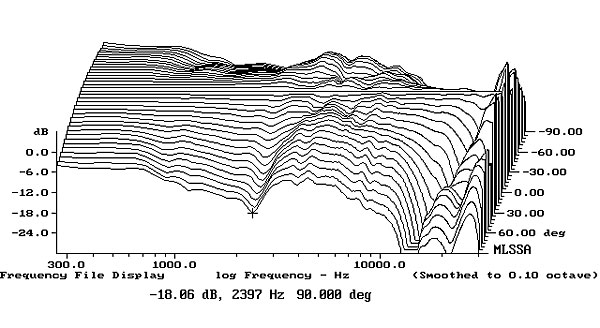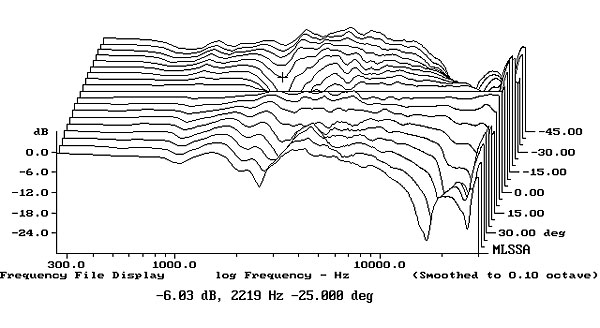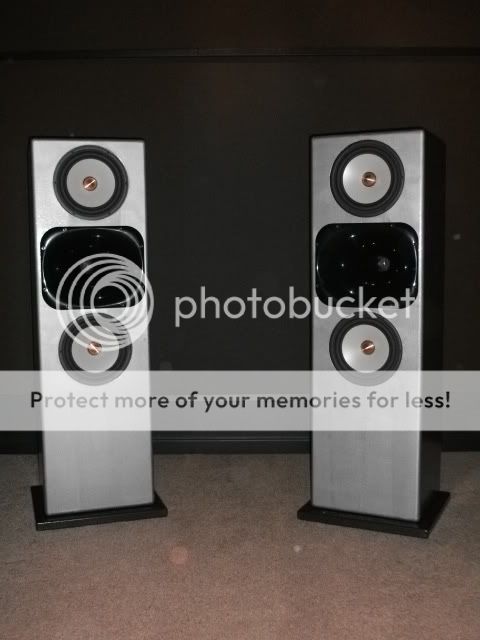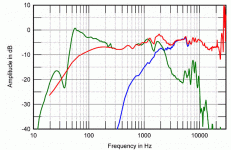I think I misunderstand something fundamental with respect to the 1/4 wavelength MTM stipulation. If I'm calculating properly, my MTM with 5" drivers and a tweeter with roughly 90mm diameter should not have a crossover frequency greater than 350Hz if it is to be within 1/4 wavelength. That seems excessively low considering the woofers and tweeter are close to as tight as they could be.
Even at 1 wavelength the crossover freq would have to be no more than 1405Hz. So my crossover frequency of 2800 Hz is roughly two wavelengths. CtC of the mids is 244mm which is apparently 1405 Hz. Am I missing something?
They do drop off in the higher frequencies vertically off axis but I don't normally stand when listening. Tweeter is at ear height (when seated).
Tony.
Even at 1 wavelength the crossover freq would have to be no more than 1405Hz. So my crossover frequency of 2800 Hz is roughly two wavelengths. CtC of the mids is 244mm which is apparently 1405 Hz. Am I missing something?
They do drop off in the higher frequencies vertically off axis but I don't normally stand when listening. Tweeter is at ear height (when seated).
Tony.
Last edited:
With the frames touching, the CTC M-T is about 4.25". That is 1 wavelength of about 3200Hz, or 1/2 wavelength of about 1600Hz, or 1/4 wavelength of about 800Hz.
The CTC of the M-M however is about 8.5". 1 wavelength of 1600Hz.
It's all compromises but, I'd go with the 1600Hz XO point 😀 Before the Ms start their own lobing.
The CTC of the M-M however is about 8.5". 1 wavelength of 1600Hz.
It's all compromises but, I'd go with the 1600Hz XO point 😀 Before the Ms start their own lobing.
If this was my dilemma, i would put together the system with a intial 6K t-m xover. Then listen how it sounds. Then drop the xover down and listen again. This way you can decide if lobbing/c-t-c is a problem.
Many are using CSS LD25X tweeter in mtm, Jeff Bagby eg. Triton But xo at 800Hz is not possible.
Domes don't go low, planars are way too large - perhaps a 2" paper cone fullrange/tweeter? Are there any really good ones? What about dispersion and power handling?
And hey, we must not exaggerate this "problem" of mtm. 2-way MTs are much worse and many of them are considerd very good!
Stereophile test ProAc Studio 100


Domes don't go low, planars are way too large - perhaps a 2" paper cone fullrange/tweeter? Are there any really good ones? What about dispersion and power handling?
And hey, we must not exaggerate this "problem" of mtm. 2-way MTs are much worse and many of them are considerd very good!
Stereophile test ProAc Studio 100


If this was my dilemma, i would put together the system with a intial 6K t-m xover. Then listen how it sounds. Then drop the xover down and listen again. This way you can decide if lobbing/c-t-c is a problem.
This is exactly what I am asking. Has someone done this?
The answer will affect how I will end up placing my drivers on the final design. And I don't have the capacity right now to test it myself.
And I am not talking about MTM.
Please just consider TM with my hypothetical question.
Okay - what about intermodulation and doppler distortion and ragged on-axis response at highest frequencies with coaxials? Yes - we meet new different problems! Even KeF UniQ drivers have them.
FWIW, here are some measurements for a current-generation KEF Uni-Q, the 8" concentric used in their Q900, on a chamfered baffle:
On-axis

Tweeter

As for IMD/Doppler, I've yet to see or hear any evidence that it's a real problem.
This thread reminds me of a recent thread on implementing a MTM with 8 inches diameter woofers. The 8” woofer MTM thread with two responses of interest is:
http://www.diyaudio.com/forums/multi-way/236479-8-woofer-mtm-trainwreck-7.html
Rory (taterworks) states in message #65:
"I have always wondered what the reasoning (grounded in physics) is for criticizing an MTM design with large woofers solely due to driver spacing. I know there is a supposed "rule of thumb" floating around out there that you don't want the distance from the acoustic center of your tweeter or your woofer to be greater than 1/2 WL at the crossover frequency. But why? What does this give you, really, so long as you listen on-axis and your crossover design accounts properly for the path length distance to each driver? The most that driver spacing can do is affect the speaker's power response, so the sound you hear on-axis might be affected slightly if your room is very live. But unless you like to stand up and sit down repeatedly while listening, or listen in a room lined with ceramic tile, why is it an issue if the vertical off-axis response begins to suffer? (Some would call this vertical pattern control.) You (most people) don't listen there. You listen in your chair, with your ears at one height off the ground for the entire session. To me, the only thing this can possibly be about is phase relationships between the output of each driver, and when you're on-axis, those line up anyway once the crossover work has been done.
I know that as DIYers, we tend to cling to every morsel of engineering information we can get our hands on, including placing high importance on mere rules of thumb that make design 'easier', but I think it's ridiculous to declare that someone's design is no good just because the drivers are spaced too far apart according to a 'rule' that is really only a recommendation for what will "usually" work well with most drivers in most speakers in most rooms. I think this is a case when a 'rule' isn't really a rule, and the designer should enjoy the results of his hard work."
Eric (mcdocod) states in message #67:
"Play in a simulation program like edge that can actually show you what happens to the response when you move off axis with big MTM designs, and you will quickly learn that all of the garbage "rules of thumb" are based on some very unusual requirements... Who needs 120 degree vertical dispersion? Most of the rules of thumb thrown around here as based on the premise that the speaker should behave as a point source with no directivity or "design axis" whatsoever. As soon are you are prepared to accept the notion that there is nothing wrong with having a limited vertical axis, the sooner you can move forward with a nice dynamically capable speaker.
An 8" MTM with 11" C-C spacing crossed over at ~1700hz will provide +/-10 degree vertical axis response with very minor effects on the response. (at 15 degrees off axis, there would be a few dB droop just below the tweeter crossover). If the listening position is 3M back or more, then the response is pretty good everywhere from sitting on the floor to standing up."
My discussion:
I’ve implemented several MTMs and the ¼ WL spacing between the woofer and tweeter ‘rule’ at crossover is nearly impossible to achieve with most drivers unless you use very small woofers and a small flange tweeter. Much analysis and measurements follow and one realizes the impracticality of many of these ‘rules’.
Rory and Eric are correct in their discussions that we don’t listen to MTMs at large vertical angles off axis. The difference between listening at sitting height (typically 36-38” and I assume tweeter height for a MTM) and standing height is about 15 degrees off axis for most listeners (assumes 10 feet distance from the speakers). Hence, previous analyses that stress the issues at large vertical angles are moot for most listening situations.
Furthermore, most recent MTMs are implemented with 4th order (or greater) acoustic crossovers so the frequency range impacted by driver interferences is reduced. I routinely listen to an open back MTM design that has an 16th order DSP crossover and one doesn’t worry too much about woofer/tweeter issues for that set of speakers. Any midrange to midrange interference is virtually negated by the small off axis listening angle.
Jim
http://www.diyaudio.com/forums/multi-way/236479-8-woofer-mtm-trainwreck-7.html
Rory (taterworks) states in message #65:
"I have always wondered what the reasoning (grounded in physics) is for criticizing an MTM design with large woofers solely due to driver spacing. I know there is a supposed "rule of thumb" floating around out there that you don't want the distance from the acoustic center of your tweeter or your woofer to be greater than 1/2 WL at the crossover frequency. But why? What does this give you, really, so long as you listen on-axis and your crossover design accounts properly for the path length distance to each driver? The most that driver spacing can do is affect the speaker's power response, so the sound you hear on-axis might be affected slightly if your room is very live. But unless you like to stand up and sit down repeatedly while listening, or listen in a room lined with ceramic tile, why is it an issue if the vertical off-axis response begins to suffer? (Some would call this vertical pattern control.) You (most people) don't listen there. You listen in your chair, with your ears at one height off the ground for the entire session. To me, the only thing this can possibly be about is phase relationships between the output of each driver, and when you're on-axis, those line up anyway once the crossover work has been done.
I know that as DIYers, we tend to cling to every morsel of engineering information we can get our hands on, including placing high importance on mere rules of thumb that make design 'easier', but I think it's ridiculous to declare that someone's design is no good just because the drivers are spaced too far apart according to a 'rule' that is really only a recommendation for what will "usually" work well with most drivers in most speakers in most rooms. I think this is a case when a 'rule' isn't really a rule, and the designer should enjoy the results of his hard work."
Eric (mcdocod) states in message #67:
"Play in a simulation program like edge that can actually show you what happens to the response when you move off axis with big MTM designs, and you will quickly learn that all of the garbage "rules of thumb" are based on some very unusual requirements... Who needs 120 degree vertical dispersion? Most of the rules of thumb thrown around here as based on the premise that the speaker should behave as a point source with no directivity or "design axis" whatsoever. As soon are you are prepared to accept the notion that there is nothing wrong with having a limited vertical axis, the sooner you can move forward with a nice dynamically capable speaker.
An 8" MTM with 11" C-C spacing crossed over at ~1700hz will provide +/-10 degree vertical axis response with very minor effects on the response. (at 15 degrees off axis, there would be a few dB droop just below the tweeter crossover). If the listening position is 3M back or more, then the response is pretty good everywhere from sitting on the floor to standing up."
My discussion:
I’ve implemented several MTMs and the ¼ WL spacing between the woofer and tweeter ‘rule’ at crossover is nearly impossible to achieve with most drivers unless you use very small woofers and a small flange tweeter. Much analysis and measurements follow and one realizes the impracticality of many of these ‘rules’.
Rory and Eric are correct in their discussions that we don’t listen to MTMs at large vertical angles off axis. The difference between listening at sitting height (typically 36-38” and I assume tweeter height for a MTM) and standing height is about 15 degrees off axis for most listeners (assumes 10 feet distance from the speakers). Hence, previous analyses that stress the issues at large vertical angles are moot for most listening situations.
Furthermore, most recent MTMs are implemented with 4th order (or greater) acoustic crossovers so the frequency range impacted by driver interferences is reduced. I routinely listen to an open back MTM design that has an 16th order DSP crossover and one doesn’t worry too much about woofer/tweeter issues for that set of speakers. Any midrange to midrange interference is virtually negated by the small off axis listening angle.
Jim
Last edited:
^ IF off-axis response would be meaningless – more precisely spectral balance between direct sound and strong early reflections – I'd agree but I believe the opposite is true.
Member
Joined 2003
Off-axis balance certainly isn't meaningless, but strong floor and ceiling reflections may be as troublesome as MTM/line compromises. With limited depth for horns, lines seem a reasonable way to achieve tight vertical response. Personally, I try to "aim" nulls and limit lobes to -10db peaks. Clearly an imperfect solution, but one of many trade-offs.
In my comments from message #29 I'm talking about vertical off axis response. With MTMs or any line array the designer has little to no control over horizontal off axis response. You have used your horizontal axis degree of freedom by vertically aligning the drivers.
In my experience I find that MTMs (and line arrays especially) help in removing some listening room issues as less sound strikes the floor and ceiling vertical boundaries. As Paul says it is a tradeoff.
In my experience I find that MTMs (and line arrays especially) help in removing some listening room issues as less sound strikes the floor and ceiling vertical boundaries. As Paul says it is a tradeoff.
^ Pallas, could you post the impulse responses of these measurements as sound files?
I didn't take them, Dave Pellegrene did. I just posted them.
My apologies. I should've given proper attribution in the earlier post.
Hi Pallas
Regarding the tweeter response, is it with or without the crossover?
No crossover, raw driver in 14" x 9.5" baffle (I think) with chamfered edge.
This thread reminds me of a recent thread on implementing a MTM with 8 inches diameter woofers. The 8” woofer MTM thread with two responses of interest is:
http://www.diyaudio.com/forums/multi-way/236479-8-woofer-mtm-trainwreck-7.html
Rory (taterworks) states in message #65:
"I have always wondered what the reasoning (grounded in physics) is for criticizing an MTM design with large woofers solely due to driver spacing. I know there is a supposed "rule of thumb" floating around out there that you don't want the distance from the acoustic center of your tweeter or your woofer to be greater than 1/2 WL at the crossover frequency. But why? What does this give you, really, so long as you listen on-axis and your crossover design accounts properly for the path length distance to each driver?
Under those conditions, and in a heavily-mutilated room (i.e. lots of "treatments") arguably no.
Under real-world conditions in a comfortable and attractive living room, with a listener not shackled to a chair, probably yes.
My discussion:
I’ve implemented several MTMs and the ¼ WL spacing between the woofer and tweeter ‘rule’ at crossover is nearly impossible to achieve with most drivers unless you use very small woofers and a small flange tweeter.
They're not that impractical, and at any rate very small woofers and a small-flange tweeter is probably what one wants if a suitable concentric driver is not available. (See measurements above for a "suitable concentric driver.") The reason is of course to maintain a smooth horizontal polar map.
David Smith (aka "speaker dave") showed us how to get it right with his Snell "Expanding Array" models over a decade ago.
A point of agreement though: vertically-arrayed woofers do seem to offer some benefits in the upper bass. I look at it like multiple subwoofers (averaging in the modal region) except that they can work higher up.
Last edited:
One of the most interesting mtms I have seen is a sort of Econowave mtm with two 10" Ws and compression/horn midtweeter. Huge as a combifridge and also bass has good vertical directivity to prevent floor effects! xo at 700Hz
Raptor by PaulW http://www.htguide.com/forum/showthread.php?35812-The-Raptor-a-10-quot-MTM&highlight=raptor

Raptor by PaulW http://www.htguide.com/forum/showthread.php?35812-The-Raptor-a-10-quot-MTM&highlight=raptor

What about large mid horns with 2" compression drivers?
Those are usually crossed somewhere around 8000Hz and CTC distance with the tweeter is much bigger than 1 wavelength due to the large diameter horn.
Does this cause any audible lobing related issues?
So once again, my original question was; can we really hear lobing anomalies due to a crossover in the region of 5-10k Hz? And once again, I am not talking about MTM anymore.
Those are usually crossed somewhere around 8000Hz and CTC distance with the tweeter is much bigger than 1 wavelength due to the large diameter horn.
Does this cause any audible lobing related issues?
So once again, my original question was; can we really hear lobing anomalies due to a crossover in the region of 5-10k Hz? And once again, I am not talking about MTM anymore.
No crossover, raw driver in 14" x 9.5" baffle (I think) with chamfered edge.
I wonder whether KEF EQ'ed the tweeter. In the raw FR, there's a 15dB drop from 2kHz-20kHz. Stereophile's measurements (below) shows the tweeter dropping off at 10kHz.
On closer examination, it seems nothing is done to tame the cone breakup of the woofer at 8kHz. So, the summed response (red trace) from 5kHz-9kHz actually contains a big portion of the cone breakup underneath (green trace).
Attachments
Member
Joined 2003
What about large mid horns with 2" compression drivers?
Those are usually crossed somewhere around 8000Hz and CTC distance with the tweeter is much bigger than 1 wavelength due to the large diameter horn.
Does this cause any audible lobing related issues?
So once again, my original question was; can we really hear lobing anomalies due to a crossover in the region of 5-10k Hz? And once again, I am not talking about MTM anymore.
You'd likely hear it with pink noise + head movement.
So once again, my original question was; can we really hear lobing anomalies due to a crossover in the region of 5-10k Hz?
Very much so in the vertical plane until you're far enough away for the c-t-c distance to appear small WRT WL size since sound decays quicker over distance with increasing frequency.
Play a musical scale and hear it 'march' down from [super]tweeter to woofer on axis and wander around while getting there if off axis; and as PW noted, it will be ear height, head position dependent.
That said, we are visually oriented, so if you're watching a movie or music video and especially if you can't see/don't know if there's any offset, our internal processor tends to do a good job of making it sound 'right' for what we're seeing.
Never tested for this with pink noise, though I used it for setting levels, EQ and don't recall ever noticing any 'marching', but admittedly was so used to it that I normally only noticed/got irritated by it when playing Edgar Winter's 'Frankenstein' [vinyl].
All that said, I ultimately swapped out the big multi-cell horn/driver and separate super tweeter horn systems for dual stacked smaller horn/drivers that actually summed to a little larger horn and driver effective piston area with the bonus of a better overall polar response to get the c-t-c spacing 'close enough' for me, until decades later when I auditioned an original Unity horn that is.
GM
Did you ever get an answer to your question here? I have been thinking about something similar lately.I am in the process of building an active 4 way.
Below and above what frequencies does the human ear become less sensitive to lobing?
In a 4 way, it is very difficult to mate the upper mid driver and the tweeter.
If lobing is unavoidable, then perhaps making it symmetrical (MTM) is preferable.
Alternatively, can we move the MT crossover point higher and use a narrow dispersion tweeter instead. This would make the lobing worse, but is there a critical frequency beyond which lobing is not audible any more.
Same Q for the bass -midbass crossover point.
- Home
- Loudspeakers
- Multi-Way
- Beyond what frequency range CTC distance becomes a non issue?
